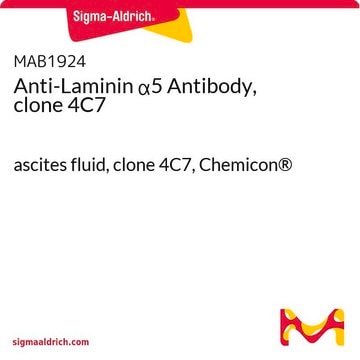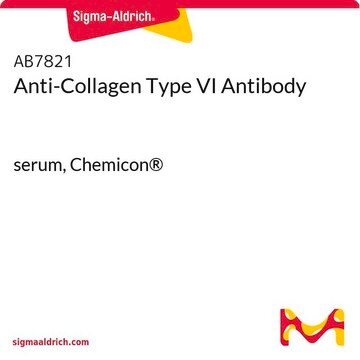MAB1944
Anti-Collagen Type VI Antibody, clone 3C4
ascites fluid, clone 3C4, Chemicon®
Synonym(s):
Collagen alpha-3(VI) chain, Collagen VI alpha-3 polypeptide
About This Item
Recommended Products
biological source
mouse
Quality Level
antibody form
ascites fluid
antibody product type
primary antibodies
clone
3C4, monoclonal
species reactivity
human
manufacturer/tradename
Chemicon®
technique(s)
electron microscopy: suitable
flow cytometry: suitable
immunocytochemistry: suitable
immunohistochemistry: suitable (paraffin)
immunoprecipitation (IP): suitable
isotype
IgG1κ
NCBI accession no.
UniProt accession no.
shipped in
dry ice
target post-translational modification
unmodified
Gene Information
human ... COL6A3(1293)
General description
Specificity
Immunogen
Application
Immunocytochemistry Analysis: Representative lots detected extracellular type VI collagen immunoreactivity in cultured fibroblasts isolated from Ullrich congenital muscular dystrophy (UCMD) and Bethlem myopathy (BM) patients by fluorescent immunocytochemistry (Kim, J., et al. (2012). Neuromuscul. Disord. 22(2):139-148; Allamand, V., et al. (2011). Skelet Muscle. 1:30; Briñas, L., et al. (2010). Ann. Neurol. 68(4):511-520; Jimenez-Mallebrera, C., et al. (2006). Neuromuscul. Disord. 16(9-10):571-582; Tétreault, M., et al. (2004). Brain. 129(Pt 8):2077-2084; Zhang, R.Z., et al. (2002). J. Biol. Chem. 277(46):43557-43564).
Immunocytochemistry Analysis: A representative lot detected exogenously expressed wild-type α3(VI) chain, as well as α3(VI) chain with G49A or G301V mutation in SaOS-2 transfectants by fluorescent immunocytochemistry (Lamandé, S.R., et al. (2002). J. Biol. Chem. 277(3):1949-1956).
Immunocytochemistry Analysis: Representative lots immunostained extracellular type VI collagen fibrils in human MG63 osteosarcoma cells and primary foreskin fibroblasts cultures (Bruns, R.R., et al. (1986). J. Cell Biol. 103(2):393-404; Engvall, E., et al. (1986). J. Cell Biol. 102(3):703-710).
Immunohistochemistry Analysis: A representative lot detected human type VI collagen immunoreactivity in frozen muscle tissue sections from mice grafted with human synovial stem cells (hSSCs) by fluorescent immunohistochemistry (Meng, J., et al. (2010). Neuromuscul. Disord. 20(1):6-15).
Immunohistochemistry Analysis: Representative lots detected type VI collagen immunoreactivity in muscle and skin samples from congenital muscular dystrophy (CMD) and Ullrich congenital muscular dystrophy (UCMD) patients by fluorescent immunohistochemistry using frozen tissue sections (Peat, R.A., et al. (2008). Neurology. 71(5):312-321; Jimenez-Mallebrera, C., et al. (2006). Neuromuscul. Disord. 16(9-10):571-582).
Immunoprecipitation Analysis: A representative lot co-immunoprecipitated type VI collagen α1(VI) and α2(VI) chains with wild-type α3(VI) chain, as well as α3(VI) chain with G16S or G49A mutation. Impaired α1(VI) and α2(VI) co-IP was observed with α3(VI) G301V mutant (Lamandé, S.R., et al. (2002). J. Biol. Chem. 277(3):1949-1956).
Immunoprecipitation Analysis: A representative lot immunoprecipitated type VI collagen alpha chains from Triton X-100 extracts of MRC-5 human lung fibroblasts (Engvall, E., et al. (1986). J. Cell Biol. 102(3):703-710).
Electron Microscopy Analysis: A representative lot detected reduced extracellular type VI collagen immunoreactivity in cultured fibroblasts isolated from an Ullrich congenital muscular dystrophy (UCMD) patient (Zhang, R.Z., et al. (2002). J. Biol. Chem. 277(46):43557-43564).
Electron Microscopy Analysis: A representative lot immunostained extracellular filaments and fibrils by binding to the band (non-helical) region of the type VI collagen fibrils using cultured human foreskin fibroblasts (Bruns, R.R., et al. (1986). J. Cell Biol. 103(2):393-404).
Dot Blot Analysis: A representative lot detected exogenously expressed wild-type α3(VI) chain, as well as α3(VI) chain with G49A or G301V mutation in the medium of cultured SaOS-2 transfectants (Lamandé, S.R., et al. (2002). J. Biol. Chem. 277(3):1949-1956).
Cell Structure
ECM Proteins
Target description
Physical form
Storage and Stability
Legal Information
Disclaimer
Not finding the right product?
Try our Product Selector Tool.
Storage Class Code
10 - Combustible liquids
WGK
WGK 1
Flash Point(F)
Not applicable
Flash Point(C)
Not applicable
Certificates of Analysis (COA)
Search for Certificates of Analysis (COA) by entering the products Lot/Batch Number. Lot and Batch Numbers can be found on a product’s label following the words ‘Lot’ or ‘Batch’.
Already Own This Product?
Find documentation for the products that you have recently purchased in the Document Library.
Our team of scientists has experience in all areas of research including Life Science, Material Science, Chemical Synthesis, Chromatography, Analytical and many others.
Contact Technical Service








